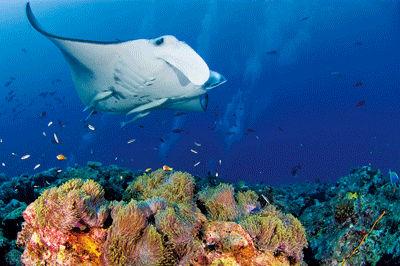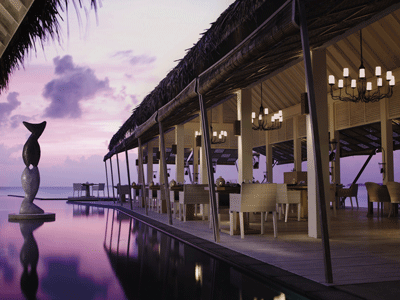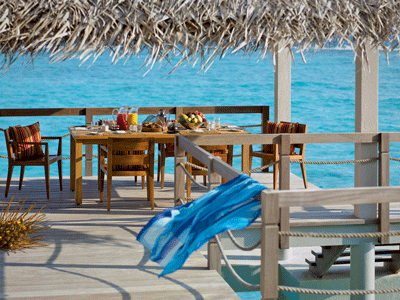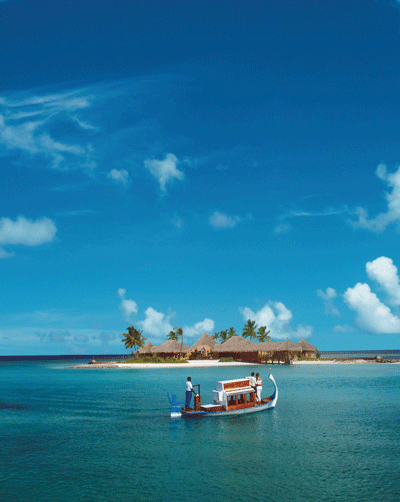For some time now, the Maldives has been a symbol of luxury travel. The archipelago of 1,190 coral islands, grouped into 26 coral atolls in the Indian Ocean, offers the perfect environment for exclusive vacations. Many international hotel groups have built resorts here, and there are also boutique ones by smaller companies. In most cases, each facility occupies an island on its own.
There isn’t a typical Maldivian experience per se. Few overseas visitors actually set foot in the capital city of Malé – although it could make an interesting cultural experience if you get a few hours or half a day to walk around in it. Most tourists are whisked away to their chosen resorts right from Malé International Airport, also located on a separate island.
Resorts in the Maldives are generally divided into the dive-oriented type, family resorts and luxury properties. There are also ones opened by investors to welcome guests from their respective countries, particularly Italian resorts where pasta is the staple food and Lavazza coffee machines are often found in the rooms.
Many of the luxury getaways are by prestigious hotel chains, serving guests from all over the world. I visited the two Four Seasons resorts in the country: Kuda Huraa and Landaa Giraavaru. The former is a smaller property about 30 minutes away by speedboat from the main airport, while the latter is a seaplane ride away, offering a much bigger area filled with greenery and surrounded by rich marine life. It is a clever strategy on the hotel group’s part to have these two properties. As seaplanes can only fly during the day, those who arrive in the evening for Landaa Giraavaru can spend the night at Kuda Huraa, instead of staying at the airport hotel.

HALF HOUR TO PARADISE
But Kuda Huraa is by no means just a transit hotel. It is a five-star getaway in its own right. Some apparently prefer it for its compact size and more social environment. Guests can easily stroll from their beach pavilions or water bungalows at the far end of the island to the restaurants, bar or activity room. On my visit, though, a rather rowdy group took over that area so I decided to stay ensconced in my water bungalow.
Suspended above water, the structure is equipped with lights at the bottom, which are turned on at night and attract the visits of underwater residents, including the occasional manta ray and non-predatory whale shark. I stood there, watching them swim by and allowing myself to soak up the magical moment.
After a good night’s sleep, I woke up to a gorgeous sunny day and decided to snorkel from right outside of my bungalow. I descended the ladder to the water from the sundeck but had to wear my rubber slippers as the sandbank was paved with rather sharp rocks and seashells. The water was hardly waist-deep even a hundred metres away from the shore but around my feet were no longer rocks. Instead, I was surrounded by marine life – colourful fish, seaweed and corals. In the evening, after a cocktail at the pool bar, I returned to my villa to change before heading off to the Indian restaurant, Baraabaru.
The open-air restaurant, shaped like a giant gazebo, is cosy and exotic. Standing in the centre of the dining hall is a striking wood-carved pillar, giving the atmosphere a sense of dignity and mystique. Further out on the water is a private dining gazebo, reachable by a bridge. I could see the chefs working their magic at the open kitchen and the tandoori action is always a draw. After another day of falling asleep to the sounds of sea waves I packed up to head to Landaa Giraavaru, at Baa Atoll on the west.

FAR AND AWAY
The seaplane is operated by an independent operator but as a guest of the hotel, a discount was given. The round-trip costs US$470. A speedboat took me to the floating platform where the plane was parked and, together with six other passengers, I boarded.
The ride turned out to be another highlight of the trip. From some 200 metres above the sea, I watched coral reefs and atolls on jewel-like waters passing by. Some of these atolls are individual resorts, looking like they were as cut off from the rest of the world as any place could be.
The plane parked at another floating platform off Landaa, where passengers were picked up by the hotel’s shuttle boat. Everything is on a much bigger scale here, including the open-air lobby. At Kuda Huraa, I often opted to walk instead of taking the buggies. Here, I chose to do the opposite, at least before I got my bearings.

My beach villa with pool was conveniently located near the gym and tennis court but, at the same time, surrounded by trees and flora. It felt like I could be in the middle of a jungle. I had my own wooden gazebo with a mezzanine floor where I could hang out with a book or just nap, and the bathroom with its big windows looking at the traditional Maldivian walls and thoughtfully planted greens made taking a bath more of a treat than it already was. As with many luxury resorts, there was also an outdoor rain shower. From my pool there was also a sand path leading out
to the beach that stretched all the way to the water sport centre, and this was also where I went jogging every morning.
The Marine Discovery Centre here serves as a base for research on manta rays and whale sharks, and there is also a lab for breeding fish. After a quick visit to the centre, I was ready to go see the marine life in the wild, and I started with dolphin watching.
On the hotel’s dhoni (a traditional boat resembling the dhow in the Middle East), I sailed out to the waters of the Baa Atolls. About half an hour in, there they were: the dolphins appeared in droves and playfully raced us. They leapt out of the water at times, and even did somersaults as if to impress us.

We made a stop at the island of Dharavandhoo, which had a modest Maldivian village. But really, it was nothing to write home about. The shops were filled with cheesy and overpriced souvenirs and from what I could gather, none of them were made locally.
I briefly considered taking up the offer to be taught how to scuba-dive in two days, but then decided that I’d stick with snorkelling and lounging around.
EAT, PLAY, LUXURY
Back on Landaa, I made use of the food and beverage facilities, at which this property truly excels. My first dinner was at the dreamy Al Barakat, named after a North African scholar who made Baa Atoll his home in the 12th century. I entered the restaurant through the wooden walkway lit by a line-up of brass lamps. The cold mezzes and grill went down really well with a few glasses of chilled white wine and the sea breezes.
The next day, after some tennis practice in the morning, I took the buggy to Blu, the Italian restaurant. At the western end of the island overlooking a 2km lagoon, this place is the perfect spot for a leisurely lunch of seafood linguine and pizza. While waiting for my food to arrive, I dipped my feet into the adjacent salt-water pool, sipping wine while marvelling at the white sandy stretch nearby. The world’s worries felt as far away as they could be.
But I had a true taste of island flavour at the beachside Fuego Grill, where I went in the evening after wakeboarding and a visit to the spa. Open only for dinner, this place has tables on the beach and right by the water, with tiki torches around looking like the set of Survivor.
This is a barbecue restaurant famous for prime steaks, but Maldivian lobsters were available that night so I decided to splash out for one. They were very similar to the Pacific spiny lobsters, which I prefer to Boston lobsters because they have a much more layered flavour although the meat is less firm. With a few glasses of champagne, the crustacean, grilled to perfection, is simply heavenly.
A resort is not complete without a spa, of course, and here you can enjoy treatments in thatched pavilions surrounded by lush greens or even above the water. The facility here also includes an Ayurvedic Retreat, where herbal baths and mud treatments are arranged alongside special diets that aim to complement your dosha (bodily type according to the Indian health philosophy). Treatments are probably best followed by a yoga session on the “floating” pavilion.
The hotel also operates a three-deck catamaran called Four Seasons Explorer, which takes up to 22 guests at a time for three- to seven-night excursions of island hopping, diving and snorkelling. It is basically a floating mini-hotel, complete with luxurious rooms and food and beverage facilities.
BACK TO THE CITY
Leaving here was not easy, but I did accept that all good things had to end sometime. I managed to squeeze out a couple of hours to take a 10-minute shuttle boat ride (US$1) to town for a walk.
It was a surreal experience in itself: on the narrow lanes and crowded roads of Malé – one of the most densely populated cities on earth because of geographical limitations – I took a stroll amidst the Muslim music and prayers broadcast from a giant speaker located near the President’s Office. Despite the decibel levels and slight chaos of this town, I felt unperturbed, because I had just come back from paradise.
COMING SOON
Anantara Kihavah Villas, scheduled to open in January 2011, features seventy-eight over-water and beach suites amidst a lush tropical environment, all equipped with private infinity pools, high ceilings, timber interiors and terrazzo floors. There will be five dining options, including one underwater. The signature Anantara Spa journey will also be offered and the facility will also promote Maldivian cultural experiences.
Jumeirah Dhevanafushi, by the Dubai-based luxury hospitality company well known in pushing decadence to new heights, is an exclusive all-suite resort scheduled to open in the first quarter of this year. It is situated in the Gaafu Alifu Atoll, 400km south of Malé. The 22 island villas offer an intimate residential feel while the exclusive water village, Ocean Pearls, includes 16 ocean villas separated from the main island. The villas, named Revives and Sanctuaries, range from 200sqm to 600sqm and offer stunning sea views, direct access to the beach and 24-hour butler service. Three restaurants and a bar are featured, as well a Talise Spa. Another property, the Jumeirah Vittaveli, is also underway. The five-star family resort is expected to open in the South Malé Atoll in March 2011.
Another property to look out for is the Raffles Konottaa Maldives, opening date to be confirmed. Carlson (www.carlson.com) plans to open a city resort near Malé called Radisson Hotel Maldives Hulhumale in 2013 while Outrigger (www.outrigger.com) has begun talks about possibly entering this lucrative market.
GETTING IN
Visa
With tourism accounting for some 20 percent of its GDP, the Maldives naturally wants to make it as fuss-free for visitors as possible. A free 30-day visa is given on arrival provided you have a valid travel document, a return air ticket and a confirmed booking with a resort. This is a Muslim country, so do not try to bring in alcohol or pork – you can get them at the hotel.
Airport
Most arrive at Malé International Airport but Gan Airport (www.ganairport.aero/), on the southern atoll of Addu, serves Milan several times a week. International airlines that fly to the Maldives include British Airways, Singapore Airlines, Malaysia Airlines and Emirates.
Money
The local currency is the Rufiya, but US dollar is the currency used at resorts ,and it is also accepted in cities and villages. US$1 is 12.8 Rufiyas.








